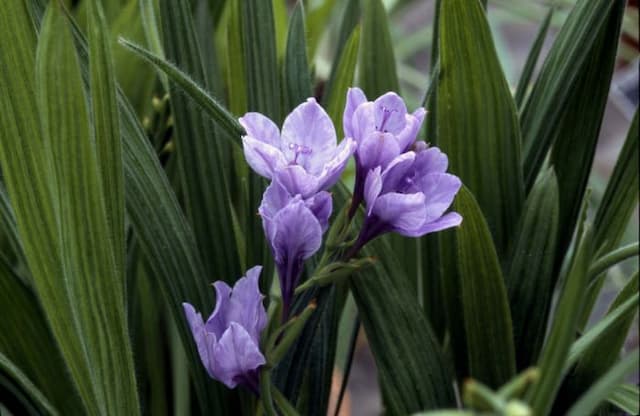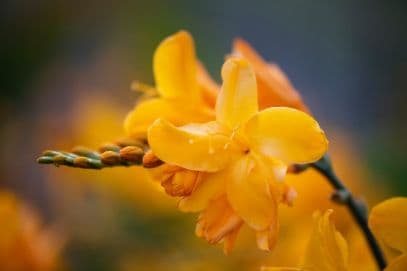Iris Iris 'Peggy Chambers' (IB)

ABOUT
Iris 'Peggy Chambers' is a type of bearded iris notable for its stunning flowers. The blooms display a harmonious color blend, showcasing shades that can range from pale yellow to creamy white. These soft hues may be complemented by a delicate lavender or purple tinge on the edges of its petals, adding a lovely contrast to the flower. Each blossom consists of six petals; three of them stand upright, called standards, while the other three, known as falls, gracefully cascade downward. The falls also exhibit a textured, fuzzy feature known as a beard, which can be found in the center of the petal and is typically a different color, providing an alluring focal point. The foliage of Iris 'Peggy Chambers' is equally attractive, forming a clumping growth habit. Long, blade-like leaves extend from the base of the stalks, giving the plant a structured, yet elegant appearance. These leaves are a deep green color and have a sword-like shape that complements the showy flowers. This bearded iris variety may also produce multiple flowers per stalk, creating a dramatic display when in full bloom. Despite its delicate looks, the iris exhibits a hardy nature and can become the star of any garden display during its blooming period.
About this plant
 Names
NamesCommon names
Iris 'Peggy Chambers' (IB).
 Toxicity
ToxicityTo humans
The Iris 'Peggy Chambers' (Intermediate Bearded Iris) is known to be toxic when ingested. The primary toxic component in the plant is the presence of irisin, iridin, or irisine, which are present throughout the plant but are most concentrated in the rhizomes—the fleshy roots. If a person eats any part of the plant, they may experience symptoms such as nausea, vomiting, abdominal pain, diarrhea, and irritation to the skin and mucous membranes. Handling the plant can also cause skin irritation in some individuals. It is important to avoid ingesting any part of the Iris to prevent these adverse effects.
To pets
Intermediate Bearded Iris is considered toxic to pets if ingested. The toxicity is mainly due to compounds such as irisin, iridin, or irisine found throughout the plant, particularly in the rhizomes. If a pet, such as a dog or cat, consumes parts of the Iris, they may experience vomiting, diarrhea, drooling, lethargy, and abdominal pain. Consumption can lead to serious gastrointestinal distress. It is advised to keep pets away from the Iris and to seek veterinary attention if ingestion is suspected.
 Characteristics
CharacteristicsLife cycle
Perennials
Foliage type
Deciduous
Color of leaves
Green
Flower color
White
Height
2 feet (60 cm)
Spread
1 foot (30 cm)
Plant type
Bulb
Hardiness zones
4
Native area
Europe
Benefits
 General Benefits
General Benefits- Ornamental Appeal: Iris 'Peggy Chambers' is admired for its striking flowers and elegant form, making it a beautiful addition to gardens and landscaping.
- Attracts Pollinators: The plant is known to attract butterflies and bees, which can help pollinate other plants in the vicinity.
- Drought Tolerant: Once established, it is relatively low maintenance and can withstand periods without water, making it suitable for dryer climates.
- Seasonal Interest: This variety of Iris typically blooms in late spring to early summer, adding seasonal color to the garden.
- Versatility: It can be planted in borders, as part of a mixed bed, or used for mass plantings, offering flexibility in garden design.
- Easy Propagation: Irises can be easily propagated by dividing the rhizomes, allowing gardeners to expand their collection or share with others.
- Deer and Rabbit Resistance: Iris 'Peggy Chambers' is not a preferred food source for deer and rabbits, reducing the likelihood of damage from these animals.
- Adaptability: This plant can adapt to a variety of soil conditions, although it thrives best in well-draining soil.
 Medical Properties
Medical PropertiesThis plant is not used for medical purposes.
 Air-purifying Qualities
Air-purifying QualitiesThis plant is not specifically known for air purifying qualities.
 Other Uses
Other Uses- The rhizomes of the Iris can be dried and powdered to use as a natural pigment in art, giving a unique hue for painters and crafters.
- Iris fibers can be used in papermaking, providing a delicate texture and visual interest to handmade papers.
- Dense Iris plantings can act as a natural barrier to soil erosion, with their rhizomes holding the soil in place effectively.
- The blooms can be used in perfumery, as the Iris has a light, pleasant fragrance that can add depth to floral perfumes.
- Though not for consumption, Iris flowers can be crystallized and used as decorative elements on cakes and desserts.
- Iris plants can serve as a natural dye for textiles, giving fabrics a soft, lavender or blue tint when used in the dyeing process.
- When dried, the seed pods can be utilized in flower arrangements and wreaths, adding an interesting shape and texture.
- Iris plants can be used in companion planting to attract beneficial insects that help in the biological control of pests in gardens.
- The robust nature of the Iris allows it to be used in reclamation projects to restore vegetation in areas disturbed by construction or erosion.
- The intricate structure of Iris petals can be used in educational settings for botanical studies and illustration purposes.
Interesting Facts
 Feng Shui
Feng ShuiThe Iris is not used in Feng Shui practice.
 Zodiac Sign Compitability
Zodiac Sign CompitabilityThe Iris is not used in astrology practice.
 Plant Symbolism
Plant Symbolism- Faith: The iris often symbolizes faith, representing belief in something beyond the physical realm or in the unknown.
- Wisdom: Historically, the iris is associated with wisdom, often depicted in art and literature as a symbol of knowledge and learning.
- Courage: Irises can symbolize courage, reflecting the flower's bold colors and upright stance, which convey a sense of bravery.
- Hope: With its striking blooms that return year after year, the iris can signify hope and the expectation of good things to come.
- Royalty: Some cultures associate the iris with royalty and regal bearing due to its majestic appearance and historically royal usage as a symbol in heraldry.
 Water
WaterIntermediate Bearded Iris, including 'Peggy Chambers,' thrive with consistent moisture but do not like to be overly wet. Water them once a week with about one inch of water, which equates to approximately 0.6 gallons per square yard. Avoid overhead watering to prevent issues with rot; instead, apply water directly to the base of the plants. Increase watering frequency during dry spells, but always allow the soil to dry out slightly between waterings. During the winter, reduce watering as the plants enter dormancy.
 Light
LightIntermediate Bearded Iris like 'Peggy Chambers' prefer full sun to partial shade. They need at least six hours of direct sunlight daily to flower optimally. The best spot for these Irises is an area that receives direct morning sunlight and partial shade during the hottest part of the afternoon to protect the blooms from excessive heat.
 Temperature
TemperatureIntermediate Bearded Iris such as 'Peggy Chambers' can survive in temperatures ranging from 14°F to 86°F. The ideal temperature range for robust growth and flowering is between 68°F and 75°F. They are cold-hardy and can withstand cold winter temperatures, but prolonged periods below the minimum may require additional mulch for protection.
 Pruning
PruningIntermediate Bearded Iris such as 'Peggy Chambers' should be pruned to remove spent blooms, which encourages reblooming. Cut back the flower stalks to the base after blooming to tidy up the plant. In late summer or early fall, after flowering season, trim back any damaged or diseased leaves. Every few years, divide the rhizomes to maintain plant vigor and to prevent overcrowding.
 Cleaning
CleaningAs needed
 Soil
SoilThe best soil mix for Intermediate Bearded Iris, which includes 'Peggy Chambers,' should be well-draining, loamy or sandy with moderate fertility. The ideal soil pH for Intermediate Bearded Irises is neutral to slightly acidic, ranging from 6.8 to 7.0. You can blend garden soil with compost and a bit of coarse sand or perlite to improve drainage.
 Repotting
RepottingIntermediate Bearded Irises such as 'Peggy Chambers' should be divided and repotted every 3 to 4 years. This prevents overcrowding and rejuvenates the plants, which can lead to more vigorous growth and improved blooming. Repotting should be done after the flowering season in late summer.
 Humidity & Misting
Humidity & MistingIntermediate Bearded Iris 'Peggy Chambers' is tolerant of a wide range of humidity conditions and does not require high humidity to thrive. They do best with natural outdoor humidity and typically prefer drier conditions to prevent rhizome rot, so avoiding excessively humid environments is advisable.
 Suitable locations
Suitable locationsIndoor
Place in a sunny spot with good air circulation.
Outdoor
Select sunny location, well-drained soil; water sparingly.
Hardiness zone
3-9 USDA
 Life cycle
Life cycleThe life of an Iris 'Peggy Chambers', commonly known as Intermediate Bearded Iris, starts with seed germination, though commercially, it is more often propagated by dividing rhizomes. Once planted, the rhizomes will establish a root system and send up shoots, with growth typically starting in early spring. As the plant matures, fans of elongated leaves emerge, forming the base for future blooms. The flowering stage usually occurs in late spring to early summer, showcasing the plant's distinctive ruffled petals in shades of purple, blue, and white. After the flowering period, the plant goes into a period of vegetative growth, storing energy in the rhizomes for the next season. The cycle concludes with a dormant phase in late fall to winter, where the plant rests until the temperatures rise again in the spring.
 Propogation
PropogationPropogation time
Late summer to fall
The Iris 'Peggy Chambers', belonging to the group of intermediate bearded irises, is often propagated through division, the most popular method for irises. This is typically done in late summer after flowering has finished or in early fall. To propagate by division, one starts by lifting the clump of irises using a fork or spade, being careful not to damage the rhizomes excessively. The clump is then gently broken apart by hand or cut with a knife to separate individual rhizomes, each with one or more leaf fans. The divisions should be trimmed of old, dead foliage and roots, leaving healthy fans with a good section of rhizome and roots. These divisions are then replanted in well-draining soil at a shallow depth, with the top of the rhizome being slightly exposed to the air, spaced about 12 to 24 inches (about 30 to 60 centimeters) apart to allow for growth. Care should be taken to ensure that the soil is kept slightly moist until new growth indicates that the division has successfully rooted and begun to establish.









